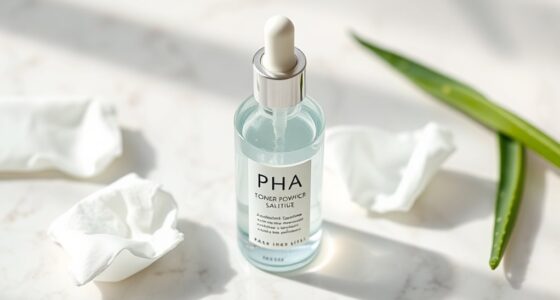When using retinol, start slow for maximum results. Begin with a pea-sized amount applied twice a week on clean, dry skin. Gradually increase the frequency as your skin adjusts, aiming for nightly use. Always follow up with a moisturizer to counteract dryness and avoid mixing with other active ingredients. Remember to wear sunscreen daily to protect against increased sun sensitivity. Stick to these retinol rules, and you’ll soon uncover more tips for radiant skin.
Key Takeaways
- Start with a pea-sized amount of retinol applied twice a week to allow your skin to adjust gradually.
- Use a gentle face wash and ensure skin is completely dry before applying retinol for optimal absorption.
- Gradually increase application frequency to daily use as your skin becomes accustomed to the product.
- Always follow up with a moisturizer to combat potential dryness and irritation from retinol.
- Protect your skin by applying sunscreen every morning, as retinol can increase sun sensitivity.

Retinol is a game-changer in skincare, offering multiple benefits for your complexion. As a derivative of vitamin A, it enhances skin cell turnover, giving you fresher, smoother skin. You’ll love how it improves collagen production, helping to reduce the appearance of fine lines and wrinkles. It also balances sebum production, tackling blemishes by removing dead skin cells and managing acne. If uneven pigmentation or acne scars are concerns, retinol effectively targets these issues, leading to significant skin brightening and anti-aging benefits with regular use. Additionally, freshly squeezed juices can provide essential vitamins that complement your skincare routine. For optimal skin health, consider incorporating mineral-based sunscreens into your routine to further protect your skin, especially since hydrating ingredients can enhance the effectiveness of your routine. Maintaining skin hydration through effective hydration techniques is crucial to support your retinol regimen.
Experience the transformative power of retinol for smoother, brighter skin and reduced fine lines and blemishes.
To get the most out of your retinol, preparing your skin is vital. Start with clean, dry skin to guarantee ideal absorption and effectiveness. Avoid applying retinol on freshly exfoliated skin, as this can cause irritation. Instead, use a gentle face wash before application, and give your skin a few minutes to calm down after washing. This wait allows any redness to subside, setting you up for success. Ensure skin is thoroughly patted dry to prevent irritations before applying retinol. Incorporating lavender oil in your nighttime routine can also help soothe the skin as it adjusts to retinol.
When you’re ready, apply retinol before your moisturizer for the best results.
When it comes to dosage and frequency, start small. A pea-sized drop is perfect for your entire face. If you’re new to retinol, begin using it twice a week and gradually increase the frequency as your skin adjusts. Work your way up to daily use, but be patient; full results can take about 12 weeks to show. If your skin is sensitive, opt for a lower concentration of retinol to minimize irritation.
Apply retinol at night to avoid increasing sun sensitivity. Use a quadrant system to distribute it evenly across your face, gently rubbing it in until absorbed. Always follow up with a moisturizer to counteract any dryness or irritation. Avoid mixing retinol with other active ingredients like AHA, BHA, or benzoyl peroxide to prevent adverse reactions.
Side effects like dryness, redness, and flaking may occur as your skin adjusts, but you can mitigate these by using a hydrating moisturizer post-application. Incorporating hydrating ingredients like hyaluronic acid or niacinamide can help retain moisture.
If you’re pregnant, it’s best to avoid retinol altogether due to potential risks. Finally, always wear sunscreen with a high SPF in the morning, as retinol can increase sun sensitivity. With these retinol rules, you’re on your way to glowing, healthier skin!
Frequently Asked Questions
Can I Use Retinol During Pregnancy or Breastfeeding?
You shouldn’t use retinol during pregnancy or breastfeeding. Oral retinoids are particularly dangerous, leading to severe birth defects, while topical forms can still pose risks due to skin absorption.
Experts recommend avoiding retinoids altogether to protect your baby. Instead, look for pregnancy-safe alternatives like azelaic acid or niacinamide, which can help manage skin concerns without the associated risks.
Always consult your healthcare provider for personalized advice before starting any new skincare products.
How Long Does It Take to See Results From Retinol?
You can expect to see initial improvements in your skin’s texture and tone within 1-4 weeks of starting retinol.
By 2-3 months, you’ll likely notice reduced wrinkles and a more even skin tone.
With consistent use over 6 months, the effects on collagen and elastin production become more visible, making your skin smoother and firmer.
Can I Mix Retinol With Other Skincare Ingredients?
Imagine your skin as a delicate canvas, ready to absorb vibrant colors. You can mix retinol with soothing ingredients like hyaluronic acid and niacinamide for hydration and reduced irritation.
However, steer clear of benzoyl peroxide and glycolic acid, as they can clash and cause chaos. Think of it as a dance; harmony creates beauty, while mismatched partners can lead to a messy performance.
Choose your combinations wisely for a radiant glow.
What Should I Do if I Experience Irritation From Retinol?
If you experience irritation from retinol, it’s essential to take a step back.
First, consider taking a break from using it to allow your skin to recover. You can also switch to a lower concentration or a gentler retinoid.
Make sure to hydrate your skin with barrier-repairing moisturizers.
If irritation persists, consulting a dermatologist for personalized advice will help you find the best way to continue your retinol journey safely.
Is Retinol Safe for All Skin Types?
Did you know that about 80% of people see improvements in their skin after using retinol?
While retinol is generally safe for most skin types, it’s not for everyone. If you have sensitive skin, start with a lower concentration to avoid irritation.
Acne-prone skin can benefit from retinol’s pore-clearing effects, but those with rosacea or eczema should approach with caution.
Always listen to your skin and adjust usage as needed.
Conclusion
Embracing retinol is like stepping into a brighter chapter of your skincare journey. By starting slow and allowing your skin to adjust, you’re nurturing its delicate balance while inviting a luminous glow. Remember, patience is key; the best results come to those who wait. So, as you commence on this transformative path, let the gentle whispers of progress inspire you. Your skin’s radiant future is just around the corner, waiting to shine with newfound confidence.










